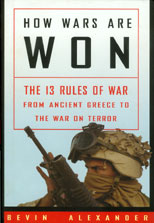 Click here to purchase from Barnes & Noble.
Click here to purchase from Amazon.com.
Click here to purchase from Barnes & Noble.
Click here to purchase from Amazon.com.
The Failure of Attacks in the Civil War
Excerpt from How Wars Are Won: The 13 Rules of War—From Ancient Greece to the War on Terror, by Bevin Alexander, pages 67-68
[Robert E.] Lee is one of the supreme examples in history of a commander who disregards the circumstances he finds himself in, and continues on a policy that is bound to result in disaster. Although most of the senior officers on both sides were unable to fathom the problem presented by the Minié-ball rifle [which quadrupled the range of the smoothbore musket], Lee had been offered a solution time after time by Stonewall Jackson, and time after time he had rejected it.
The value of the defensive approach was no secret in the Army of Northern Virginia. James Longstreet, a corps commander, and Porter Alexander, his artillery chief, most certainly knew it. Alexander remarked, “When all our corps were together, what could successfully attack us?” Longstreet believed he had extracted from Lee a promise to maintain the tactical defensive in Pennsylvania, and Lee actually intended to do so. As events were to show, however, he reverted to his old offensive habit the moment he faced a challenge.
The strength of the defense had actually become even greater by 1863. Field fortifications were now standard because officers recognized they could stop bullets. At the same time cannons, especially nimble twelve-pounder Napoleons (named after Napoleon III, not the emperor) sometimes moved up alongside defending troops, where they spewed out canister, a deadly cloud of metal fragments, at oncoming enemy. This trinity---the Minié-ball rifle, field fortifications, and canister-armed cannons---now was making it virtually impossible to attack and win.
<< More 'Civil War' Excerpts << Back to top